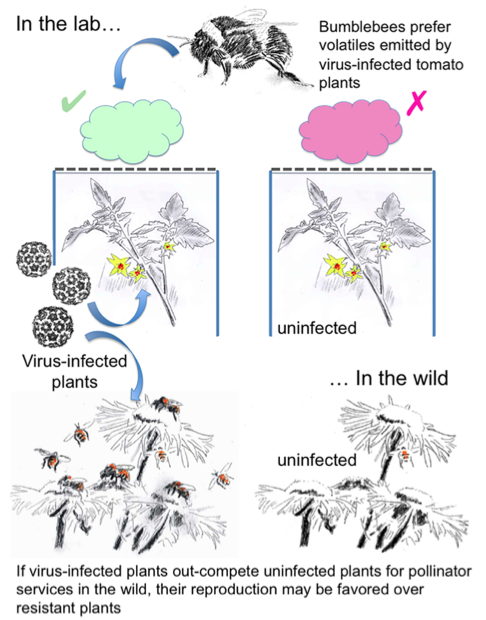This weeks Arabidopsis Research Roundup includes three papers across a wide range of topics. Firstly is a widely-reported study, described here with an audio description by Nik Cunniffe and Sanjie Ziang, of the evolutionary relationship between viral infection, pollinator attraction, plant fertility and miRNA-regulated gene expression. Secondly, Gordon Simpson is a co-author on a paper that has elucidated the crystal structure of the FPA proteins and finally Gareth Jenkins leads an investigation into the relationship between UV light, the UVR8 protein and histone modifications.
Groen SC, Jiang S, Murphy AM, Cunniffe NJ, Westwood JH, Davey MP, Bruce TJ, Caulfield JC, Furzer OJ, Reed A, Robinson SI, Miller E, Davis CN, Pickett JA, Whitney HM, Glover BJ, Carr JP (2016) Virus Infection of Plants Alters Pollinator Preference: A Payback for Susceptible Hosts? PLoS Pathog. 12(8):e1005790
http://dx.doi.org/10.1371/journal.ppat.1005790
Open Access

This pan-UK collaboration is led by John Carr, Beverly Glover and Nik Cunniffe at the University of Cambridge and has received wide attention in the general press. Nik Cunniffe also kindly provides an audio description of this work that looked into the effect of viral infection on the attraction of pollinators. The authors used GC-MS to look at the volatiles produced in virally infected Arabidopsis and tomato plants, showing that infection can alter the foraging behavior of bumblebees. Mutational analysis of both cucumber mosaic virus (CMV) and Arabidopsis showed that the microRNA pathway is involved in regulating the emission of these pollinator-perceivable volatiles. When virus-infected tomato plants were not pollinated there was a clear reduction in seed yield, indicating that the plant requires the volatile production following viral infection to attract pollinators, leading to reproductive success. Importantly the authors model the possible trade-off between viral infection and reproductive success in the wild, which might oppose the strong selective pressure for the establishment of disease-resistance genes. The authors speculate that this is a co-beneficial relationship for both virus and plant.
Nick Cunniffe and Sanjie Jiang kindly provide an audio description of this work.
Zhang Y, Rataj K, Simpson GG, Tong L (2016) Crystal Structure of the SPOC Domain of the Arabidopsis Flowering Regulator FPA PLoS One 11(8):e0160694
http://dx.doi.org/10.1371/journal.pone.0160694
Open Access
Gordon Simpson (University of Dundee) in a co-author on this US-led study that has elucidated the crystal structure of the SPOC domain of the FPA floral regulator protein. FPA contains a N-terminal RNA recognition motif and a C-terminal SPEN paralog and ortholog C-terminal (SPOC) domain. This SPOC domain is highly conserved throughout plant species and this crystal structure is an important development in our understanding of the regulation of RNA 3’-end formation and how much the plant SPOC domains compare with an equivalent from metazoans.
Velanis CN, Herzyk P, Jenkins GI (2016) Regulation of transcription by the Arabidopsis UVR8 photoreceptor involves a specific histone modification Plant Mol Biol.
http://dx.doi.org/10.1007/s11103-016-0522-3
Open Access
Gareth Jenkins (Glasgow) leads this study that continues his groups work on the Arabidopsis UVR8 photoreceptor. They show that UV-B exposure increases histone lysine acetylation on UVR8-regulated genes in a UVR8 dependent manner. In fact all of the histone enrichments throughout the genome following UV-B required UVR8 activity. However the authors could find no direct interaction between UVR8 and the known enzymes involved in light-mediated histone modification indicating that UVR8 either interacts with a novel set of proteins or the UVR8 effect is mediated via a currently unknown signaling intermediate.

- cheap pfizer viagra
- levitra cost
- test cialis 10mg
- read more
- buy cialis levitra
- can you buy real viagra canada
- buy cialis johannesburg
- read more
Podcast: Play in new window | Download




